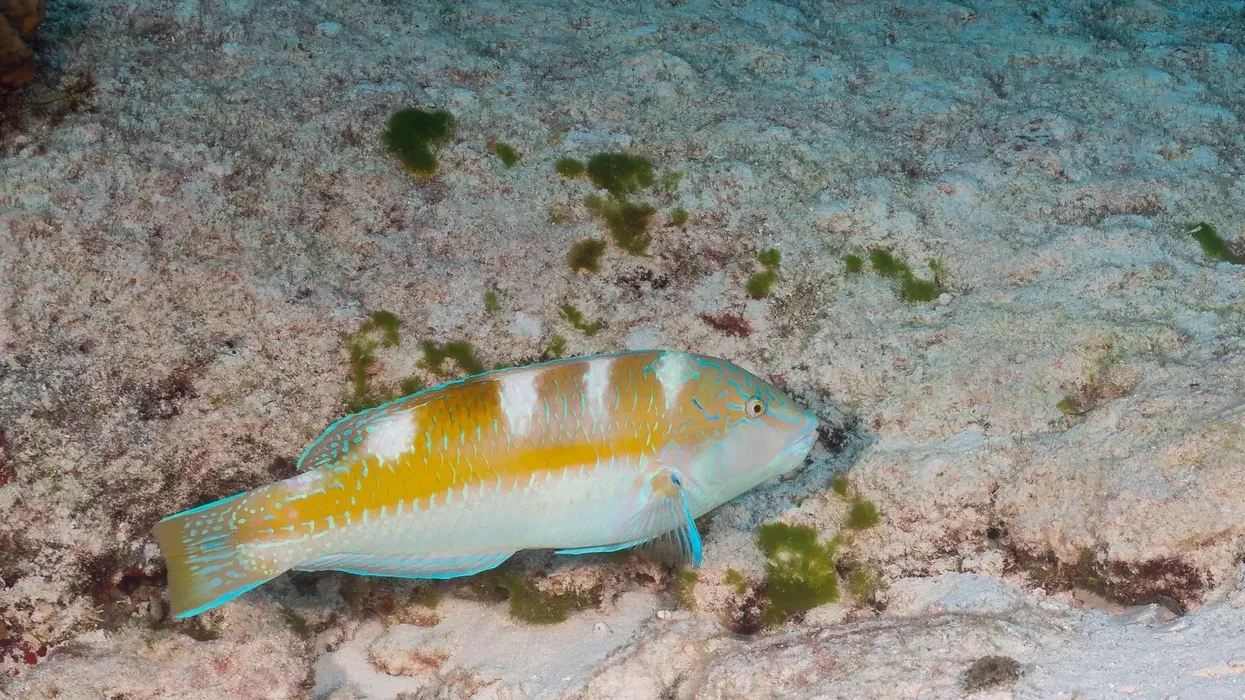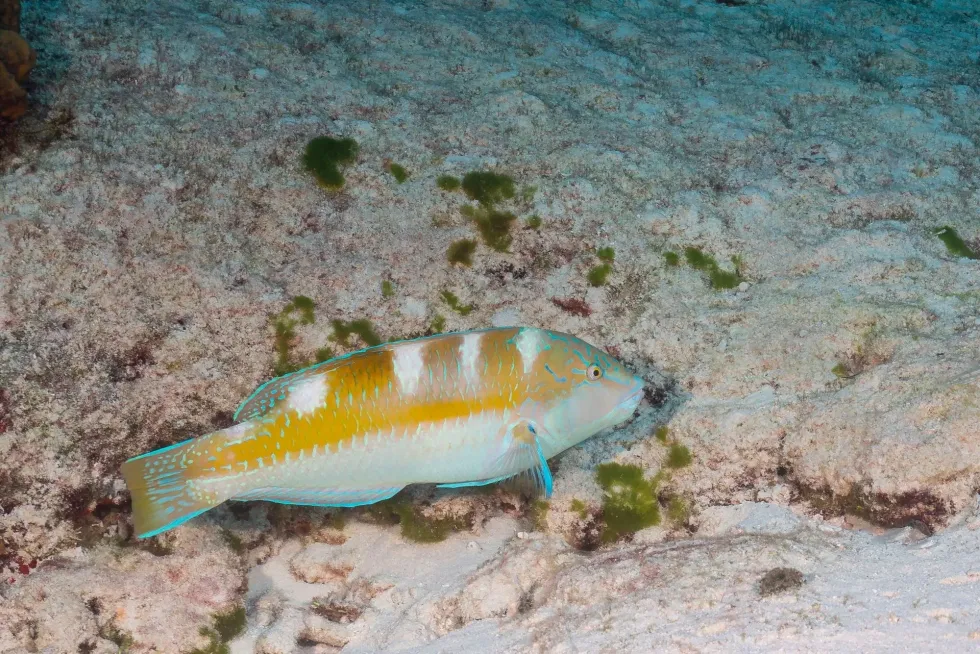The puddingwife wrasse is a brightly colored marine tank fish with a wide range of habitats in Central America, the western Atlantic, Caribbean, Bermuda, and the Gulf of Mexico. These wrasses can be seen in commercial markets and in-home aquariums and tanks with coral reef safe environments as they need moderate care levels.
They can go deep down into the water columns near the coral reefs and are diurnal. These wrasses are mostly found near lagoons and reef flats. The puddingwife wrasse is solitary. Their diet includes sea urchins, snails, crabs, and shrimp.
These wrasses have an inner ear structure that enables them to sense acoustic signals and acceleration. These small fish are commercial tank fish and are listed as of Least Concern by the IUCN.
If you enjoyed reading about these tank fish, then do read some other interesting articles on wrasse facts and humphead wrasse facts.
Puddingwife Wrasse Interesting Facts
What type of animal is a puddingwife wrasse?
The puddingwife wrasse is one of the small, beautiful marine species among all the wrasses found in Central America and the Caribbean. These wrasses are known to be less aggressive and require moderate to normal care levels if kept as a pet in a tank.
What class of animal does a puddingwife wrasse belong to?
The puddingwife wrasse belongs to the class of Actinopterygii and the family Labridae. They are from the genus Halichoeres and are scientifically known as Halichoeres radiatus.
How many puddingwife wrasses are there in the world?
The exact number of these semi-aggressive wrasses is unknown. They can be seen in commercial markets and in aquariums and tanks with coral reef environments as they need moderate levels of care.
Where does a puddingwife wrasse live?
The puddingwife wrasse is native to Central America, the Caribbean, and the western Atlantic. They can be found in Bermuda, the West Indies, and the Gulf of Mexico. They are also seen in offshore areas of Brazil, while these wrasse species are not present in coastal areas of Brazil.
What is the puddingwife wrasse's habitat?
These wrasses are mostly found near lagoons and reef flats. This habitat usually protects them from their predators and high tides.
They are found on sand and rock substrates. They can go deep down into the water columns near the coral reefs. They are diurnal and juveniles sleep under the sand bed, while adults sleep in the cracks of the reef.
Who does puddingwife wrasse live with?
Puddingwife wrasses are solitary marine species and adults can be seen living their individual lives, while the juveniles are seen in groups near the reef to protect themselves from predators.
How long does a puddingwife wrasse live?
The exact life expectancy of these reef-safe marine wrasse species is unknown, but generally, wrasses can live up to a maximum age of 30 years and a minimum age of five years depending upon the species and their environment.
How do they reproduce?
They are believed to reproduce sexually, but not much information is available in context to their reproduction. Most of the wrasse species have different mating systems. Some breed in groups, while others breed in pairs. The male body majorly decides the mating.
In general, a female wrasse lays around 1000 eggs which are planktonic in their behavior. The adults and their newborns usually have no contact with their parents. The larvae live on their own and the juveniles are seen in groups of five to eight.
What is their conservation status?
The puddingwife wrasse, Halichoeres radiatus, is listed as a Least Concern species by the IUCN. They have a wide distribution range in marine reef-safe regions. They are approved for commercial usage and can be kept in aquariums or tanks as pets.
Puddingwife Wrasse Fun Facts
What do puddingwife wrasses look like?

The puddingwife wrasse, Halichoeres radiatus, is a beautiful, colorful reef-safe fish. These marine species vary from yellow to green, white to gray, and blue.
They have black, green, blue, and white lateral lines and patches on their bodies with a brush like caudal fin or tail. There is a dark black spot or patch on their dorsal and caudal fins. They have a yellow bronze color around their eyes and a small transparent pectoral fin.
The young juveniles also look the same but with fewer lateral lines and stripes on their bodies in comparison to the adult puddingwife wrasse. Their color varies from yellow to blue.
How cute are they?
These wrasses are no doubt very cute due to the color variation on their bodies. They would be given a rating of four out of five with regards to their cuteness level.
How do they communicate?
These marine wrasses have an inner ear structure that enables them to sense acoustic signals and acceleration.
How big is a puddingwife wrasse?
The puddingwife wrasse, Halichoeres radiatus, is 15-20 in (38-51 cm) long. The largest puddingwife wrasse found was in the western Atlantic Ocean and the Caribbean Sea.
How fast can a puddingwife wrasse swim?
The exact swimming speed of puddingwife wrasses has not been evaluated.
How much does a puddingwife wrasse weigh?
The puddingwife wrasse weighs around 35-56 oz (1-1.5 kg). Most of the world's largest fish are found in the western Atlantic Ocean and the Caribbean Sea.
What are the male and female names of the species?
The male and female of the species do not have any sex-specific names.
What would you call a baby puddingwife wrasse?
The babies of the puddingwife wrasse, Halichoeres radiatus, are called larvae.
What do they eat?
Their diet consists of snails, crabs, shrimp, brittle stars, bivalves, and sea urchins. Their diet is similar to any other medium to small fish.
Are they dangerous?
No, these wrasses are not dangerous and are considered less aggressive. These species are solitary and less social, thus they can attack other species of wrasses and small-sized fish species if provoked.
Would they make a good pet?
Yes, they would make a good pet and are commercial fish in the aquarium or tank fishing market. These reef-safe fish require moderate care and should not be kept with other small fish.
Though they are less aggressive, they can be dangerous for small fish. They can be a good option to be kept in a tank, but as they can jump out of the water, the tank must be covered with a lid.
Did you know...
The puddingwife wrasse looks like a colorful reef fish that camouflages well in coral reefs and lagoons.
The humphead wrasse is the largest wrasse in the family Labridae. The wrasses have more than 600 species with 82 genera and are found in tropical-temperate sea regions.
Can you eat puddingwife wrasse?
Yes, you can eat puddingwife wrasse. Most wrasse fish are edible and are eaten because of their soft white flesh.
How did the puddingwife wrasse get its name?
These less aggressive puddingwife wrasses of the reef get their name from the bright colors. They are colorful, like a pudding that is served to you a meal.
Here at Kidadl, we have carefully created lots of interesting family-friendly animal facts for everyone to discover! Learn more about some other fish from our rainbow cichlid fun facts and interesting severum facts for kids.
You can even occupy yourself at home by coloring in one of our free printable striped surgeonfish coloring pages.
Second image by Brian Gratwicke.









